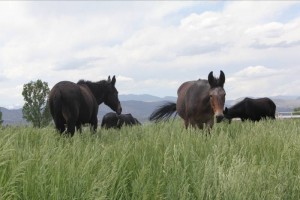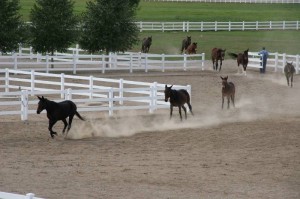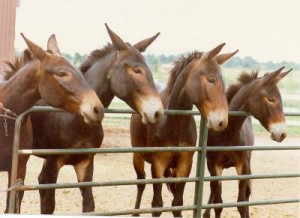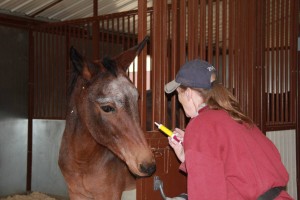What About Muzzles?
 Years ago, I believed that all I needed to have an equine was a halter, bridle and saddle, a water bucket and a patch of grass with a fence around it. I didn’t even think about shelter until much later when I finally decided that a garage would do. I now know that there is a lot of responsibility in taking care of equines and that it is an ongoing learning experience. Like most of us, I was a little lazy and wanted shortcut ways to deal with my equines so I could get right to the pleasure of riding. After many heart wrenching experience, I discovered that I did not have to be overwhelmed with management and training responsibilities, just more organized and practical. Finding simple, logical and appropriate answers to management and training questions became my mission.
Years ago, I believed that all I needed to have an equine was a halter, bridle and saddle, a water bucket and a patch of grass with a fence around it. I didn’t even think about shelter until much later when I finally decided that a garage would do. I now know that there is a lot of responsibility in taking care of equines and that it is an ongoing learning experience. Like most of us, I was a little lazy and wanted shortcut ways to deal with my equines so I could get right to the pleasure of riding. After many heart wrenching experience, I discovered that I did not have to be overwhelmed with management and training responsibilities, just more organized and practical. Finding simple, logical and appropriate answers to management and training questions became my mission.
Mules and donkeys, contrary to popular belief, are sensitive to colic and founder when left on pasture. They can develop fat rolls and patches all over their bodies when allowed to graze freely. This eventually will become a very expensive and potentially devastating condition if left unattended. Muzzles have been developed to keep equines from grazing too voraciously and hopefully, this can prevent the incidence of colic and founder, but I can’t help but think that there will be a certain amount of frustration involved when using such short cut devices that can manifest itself in other areas of interaction with your equine. The animal will take to the muzzle because there is a reward of grazing to follow, but to be prevented from fully enjoying their grazing has to be frustrating at times.
Beyond the incidence of possible frustration is the simple threat of them getting the muzzle caught on something with no one around to help them if they do get caught on anything. One of my strictest safety rules is to never leave a halter on an unsupervised animal for the same reason. I have seen too many animals maimed, paralyzed and even killed by leaving anything around their neck and head.
The muzzle encircles the delicate muzzle of the equine where the skin is very thin and sensitive. The lips can become scabby and sores can develop on the tongue.
A muzzle can chafe and burn these sensitive areas with prolonged use and create a very sore mouth. Again, if they do get sore, using a bit can become painful and cause resistance in training.
 It is easier to employ simple management practices to keep your equine healthy and happy. Your equine should be kept in a smaller area for evening feedings, overnight and for morning feedings. This has several benefits: 1) Each animal can be checked every day for any injuries or anomalies, 2) He will not have to fight for his food, he can sleep uninterrupted and be more calm and fresh each day, 3) You will then be able to turn him out at specific times for grazing during the day and he will willingly come back from the pasture each night. This way you can monitor his grazing intake so he will not be able to overgraze and colic, or founder, 4) the smaller area affords you a confined space for beginning training so there is no need to chase him, or be interrupted by other animals.
It is easier to employ simple management practices to keep your equine healthy and happy. Your equine should be kept in a smaller area for evening feedings, overnight and for morning feedings. This has several benefits: 1) Each animal can be checked every day for any injuries or anomalies, 2) He will not have to fight for his food, he can sleep uninterrupted and be more calm and fresh each day, 3) You will then be able to turn him out at specific times for grazing during the day and he will willingly come back from the pasture each night. This way you can monitor his grazing intake so he will not be able to overgraze and colic, or founder, 4) the smaller area affords you a confined space for beginning training so there is no need to chase him, or be interrupted by other animals.
If you feed only grass hay in the mornings and feed his oats mix in the evenings with grass hay, you can monitor his pasture time easily. In the spring when the grass is growing and very rich, you can begin to turn him out an hour before feeding time and he will happily come back in to get his evening oats. Then add an additional hour each week to slowly accustom his digestive tract to the new grass until you have worked him up to a maximum grazing time of five hours. This will generally produce a healthy, happy animal of any age that can maintain his ideal weight and body condition.
 When you feed only grass hay in the mornings, he will look forward to his lessons with you and be waiting at the gate, knowing there are oats rewards to be earned. What your animal is eating can have a direct impact on his response to training. Many feeds can cause hypertension in Longears (and horses, too!) and an inability to focus for any length of time. Mules and donkeys require a lot less feed than horses because they are half donkey and donkeys are desert animals. Too much feed or the wrong kind of feed and you run the risk of colic, or founder.
When you feed only grass hay in the mornings, he will look forward to his lessons with you and be waiting at the gate, knowing there are oats rewards to be earned. What your animal is eating can have a direct impact on his response to training. Many feeds can cause hypertension in Longears (and horses, too!) and an inability to focus for any length of time. Mules and donkeys require a lot less feed than horses because they are half donkey and donkeys are desert animals. Too much feed or the wrong kind of feed and you run the risk of colic, or founder.
 We feed an oats mix to our average sized mules of 1-2 cups of crimped oats, 1 oz. of Sho Glo vitamins (by Manna Pro) and 1 oz. Mazola corn oil (for hooves, coat and digestive tract regularity). The oats must be broken open in some way (crimped, steamed, rolled, etc.) as equines cannot digest whole oats. We feed this once a day in the evenings, grass hay twice a day and we monitor weight gain with the hay and pasture intake. Miniatures get one fourth as much of the oats mix and grass hay, and draft animals will need twice as much. Do not alter or modify this with other products in any way for the best results.
We feed an oats mix to our average sized mules of 1-2 cups of crimped oats, 1 oz. of Sho Glo vitamins (by Manna Pro) and 1 oz. Mazola corn oil (for hooves, coat and digestive tract regularity). The oats must be broken open in some way (crimped, steamed, rolled, etc.) as equines cannot digest whole oats. We feed this once a day in the evenings, grass hay twice a day and we monitor weight gain with the hay and pasture intake. Miniatures get one fourth as much of the oats mix and grass hay, and draft animals will need twice as much. Do not alter or modify this with other products in any way for the best results.
Also, make sure they have access to a trace mineral salt block for their salt and mineral needs. We worm our equines with Ivermectin in January, March, May, July and September and then break the cycle with Strongid in November. We vaccinate in the spring and fall. Consult your veterinarian for the types of vaccines you will need for your area. You should never feed Longears (donkeys, or mules) any pre-mixed sweet feeds, or products high in alfalfa. This is actually a very easy and inexpensive way to manage the feeding and grazing of your equines without the worry of muzzles. It’s just a matter of getting into this healthy routine.




